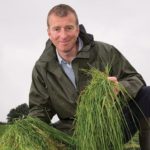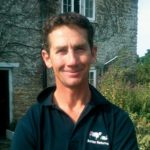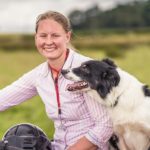Grass Watch: Growth rates lift as spring arrives
Grass growth rates are slowly gaining pace – even in Scotland – as spring ushers in some sunshine and lifts soil temperatures on our seven Grass Watch farms.
Despite some heavy rain and even snow in some parts of the country earlier this month, the end of March has been kinder, with some farms now looking ahead to their second round.
See also: Grass Watch: Warm winter leads to good grass growth across UK
Robert Craig

Robert Craig © John Eveson
- Land Total 210ha
- Stock 430 New Zealand/Kiwi-cross cows
- Altitude Ranges from 160-210m above sea level
- Calving Spring calving
It feels less like an early spring today than yesterday, with the fell tops white with snow in late March and temperatures hovering near 2C.
Grass wise, we are at least a couple of weeks ahead of 2016, while also growing slightly more daily dry matter.
At just about 30 days to go until balance day, we have grazed 40% of the milking area, although late winter rain has increased the challenges on some of the wet parts of the farm.
Dairy youngstock is happily grazing, with the remaining yearlings expected to be out grazing towards the end of March. The plan is to follow the milking herd with slurry, but to date the rain has delayed this until ground conditions improve.
We are three weeks into calving and just over two-thirds through. All is going well, with good numbers of heifer calves produced and well on their way towards weaning. To date all grazing paddocks have received their first application of 40kg of N/ha.
|
Stocking rate on grazing platform (cows/ha) |
3.41 |
|
Growth rate on platform (kg DM/day) |
15 |
|
Average farm cover (kg DM/day) |
2,115 |
|
Yield (litres a cow a day) |
24 |
|
Fat (%) |
4.9 |
|
Protein (%) |
3.35 |
|
Milk solids (kg a cow) |
1.98 |
|
Supplements fed (k a cow a day) |
6 |
|
Average rainfall (mm/day) |
74 (February total) |
|
Land type |
Free-draining sandy loam |
|
Figures correct up to 21 March |
|
Mike Miller
- Land: 106ha
- Stock 420 NZ Suffolk-cross Mules and 100 NZ Romney ewes
- Altitude 100m above sea level

Mike Miller
Enough rain fell at the start of the month to make any fieldwork impossible.
A brief dry spell meant plans were made to apply nitrogen, but then we had 18mm in one night, so it has remained in its bag.
Despite this, soil temperatures gradually increased to about 10C by mid-March and grass growth has been strong.
In comparison with last year, when the cold spring meant lambing came too soon for grass supply, this year we could do with ewes lambing to get them out on to the covers, which are already more than 2,000kg/ha in some paddocks.
Lambing will start in earnest from 1 April and hopefully freshly calved cows will be able to go out soon when ground conditions permit.
|
Cows or ewes a hectare |
1.1 livestock unit |
|
Growth rate (kg DM/ha) |
30 |
|
Average farm cover (kg DM/ha) |
1,740 |
|
Land type |
Heavy clay |
|
Rainfall (mm) |
48mm month to date |
|
Figures correct as of 22 March |
|
Sam Chesney
- Stock 150 Limousin sucklers
- Altitude 30m above sea level

Sam Chesney © Steffan Hill
Calving and lambing is in full swing here.
We have just had new high-tech weather station installed that measures everything from soil temperature to hours of sunlight.
All our information will be used, along with data from 18 other beef farmers in the province, to enable NI farmers to use and grow their grass better. The project is being funded by the Agri-Food and Biosciences Institute (AFBI) and Agri-Research Ireland.
Grass covers are probably too strong at 2,935kg DM/ha, but sheep and cattle will be entering the grazing block as I speak. January cattle remained at grass and some have already been at grass for 70 days.
Grass quality is excellent at 25.8% crude protein, 19.8% dry matter and 12.3 ME.
The grazing block has been measured for the past three weeks and growth is starting to increase at about 20kg DM/ha.
|
Cows a hectare |
8 |
|
Growth rate (kg DM/ha) |
20 |
|
Average farm cover (kg DM/ha) |
2,935 |
|
Land type |
Medium to heavy clay |
|
Rainfall (mm) |
58 (up to 23 March) |
Ben Richards
- Land 146ha
- Stock 280 Jersey-cross Friesians
- Altitude 110m above sea level
- Calving Spring-calving

Ben Richards
I have the farm back under control.
The calved cows started grazing on 14 February and when ground conditions allowed, the dry cows grazed by day and went back on the calving pad at night.
For the past week the dry cows have been out full time. The milking herd (now at 220 head) has started the second round today, with a pre-graze cover of 2,850kg DM/ha.
I now have a wedge established and the farm is looking good for the second round. Some of the wetter parts couldn’t be grazed down to an acceptable residual without pugging damage. This is the norm at Trelan.
High covers help when grazing wetter land early in the season. Just be flexible with residuals and don’t look at the paddock for a week.
Calving has gone very well so far, with 120 cows calved in 12 days and 85% calved in four weeks. Hopefully we should be all done in another week.
Drenching and teat spraying the dry cows has been well worth the effort, with little metabolic/mastitis problems, and the somatic cell count has been easier to manage than in previous years. Maybe it is a throwback from dropping our dry cow therapy.
|
Stocking rate on grazing platform (cows/ha) |
3.05 |
|
Growth rate on platform (kg DM/day) |
55 |
|
Average farm cover (kg DM/day) |
2,250 |
|
Yield (litres a cow a day) |
17 |
|
Fat (%) |
4.51 |
|
Protein (%) |
3.79 |
|
Milk solids (kg a cow) |
1.39 |
|
Supplements fed (kg a cow a day) |
0 |
|
Average rainfall (mm/day) |
18 |
|
Land type |
Heavy clay to clay loam |
|
Figures correct up to 21 March |
|
Richard Fryer
- Land 97ha
- Stock 230 Friesian cows plus 120 youngstock
- Altitude 40m
- Calving Autumn block calving. Mainly grass based

Richard Fryer
After a very dry winter, storm Doris ushered in very wet weather.
Cows had been out for a week until this point, but the following two weeks were spent back inside.
We are now grazing again and making good progress on the first grazing round. However, we are still behind on our spring rotation planner. At least regrowths are looking well.
Flexibility is key at this time of year. Lots of gateways and on/off grazing help us to keep as much grass in the diet as possible without doing too much damage to the paddocks.
We have applied 45kg N/ha to all grassland, with slurry also applied on the silage ground.
|
Stocking rate on grazing platform (cows/ha) |
4.6 |
|
Growth rate on platform (kg DM/day) |
21 |
|
Average farm cover (kg DM/day) |
2,215 |
|
Yield (litres a cow a day) |
19 |
|
Fat (%) |
4.8 |
|
Protein (%) |
3.7 |
|
Milk solids (kg a cow) |
1.6 |
|
Supplements fed (kg a cow a day) |
4 |
|
Average rainfall (mm/year) |
800 |
|
Land type |
Medium |
|
Figures correct up to 20 March |
|
Alice Muir
- Land Langholm Farms: 7,085ha, mainly heather hill with 400ha of permanent grassland; 80m-404m
- Stock: 1,560 Blackface Ewes, 1,100 Scottish Country Cheviot ewes, 900 Greyface/Aberfield ewes and 50 Galloway Cows
- Altitude 80-404m

Alice Muir
This month we have been preparing for lambing, which started on 23 March.
The ewes continue to look well – if not too well – and we have had some prolapse issues, but hopefully this has subsided now.
The grass is growing now and the farm definitely looks greener. The growth rate has increased from 2kg DM/ha/day up to 11kg, which is still not much, but it has given us something on which to turn ewes with lambs out.
We have now firmed up plans for the rotational this year and the intention is to do a leader-follower system.
Grazing the ewes in front of the hoggets to see if this will help both the grass use and keep giving the ewes and lambs the best pickings. We will soon start with fencing to accommodate this.
|
Cows or ewes a hectare |
Ewes currently housed |
|
Growth rate (kg DM/ha) |
11 |
|
Average farm cover (kg DM/ha) |
1,750 |
|
Land type |
Peat/clay |
|
Average rainfall (mm/day) |
3.3 |
The importance of quality soil
Gareth Davies, independent grassland expert
As I write this, it seems as if spring has arrived. A weekend of wall-to-wall sunshine makes everything look a whole lot better, especially the fields and the animals.
You can see from our contributors they have all been grazing for quite a while, but in a controlled manner. This early grazing is vital to stimulate the plant to grow, but you must use a graze-and-rest policy or you won’t see the true benefits.
This early, well-planned grazing is critical, as it sets the entire farm up for the coming season, providing the farm with the maximum quantity of high-quality grass.
I have mentioned previously in this column that it is the quality that matters. It is a pet hate of mine when I read the statement that “grass is your cheapest feed”. This simply isn’t true. “Quality grass” is your cheapest feed. Poor grass is a very expensive feed. If you want quality animal performance, they need top-quality feed, whether in the field, clamp, bale or bag.
Another thing that is a constant frustration is the lack of soil sampling in the UK.
This is a costly oversight. We should be working in harmony with our soils, not trying to dictate to them. Soil sampling is the obvious starting point.
Find out what is going on with your soil and start to rebalance it. If you want quality grass, a good starting point is healthy soil. Remember, there is only one type of farmer – a soil farmer.
I would also like to urge all farmers to get at least some of their animals out grazing in a controlled manner if they haven’t already done so. The sooner you start, the better.
